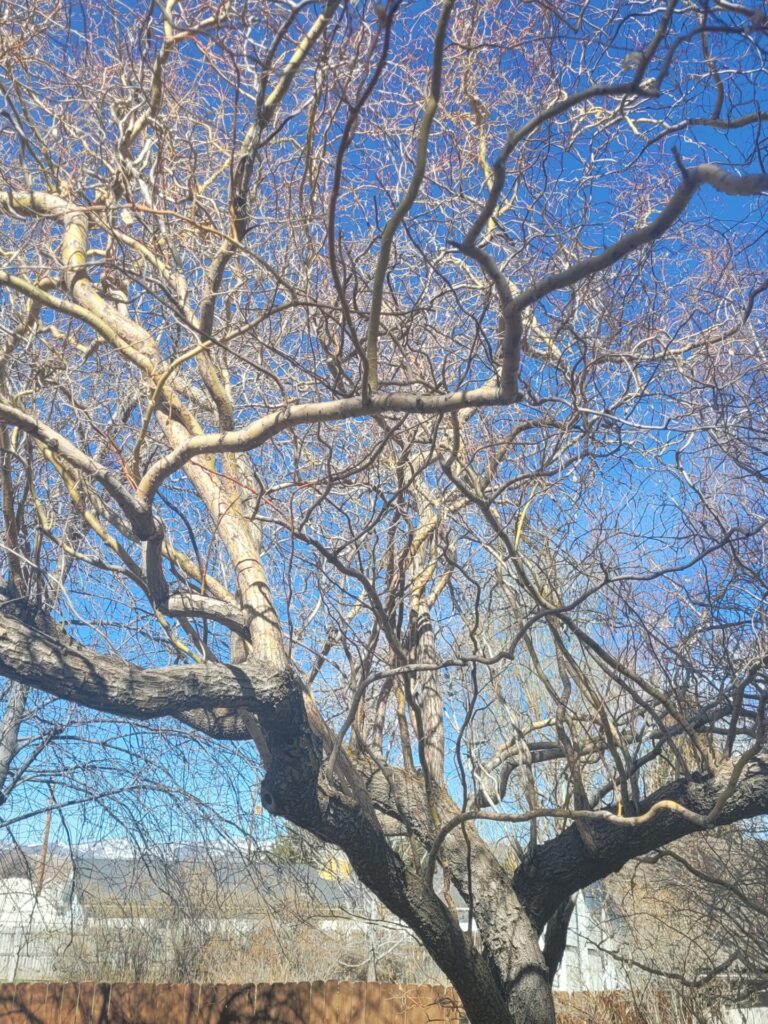
Is it dead?
Good question! You haven’t mentioned the area you live in, so it’s difficult to know your growing conditions and recent climate. Willows in Toronto have a flush of light green and yellow currently. This is their yellow catkins flowering amongst tiny young curly leaves. I can see my neighbours Corkscrew Willow, Salix babylonia var. Tortuosa, from my window. Yours looks like it could be a Corkscrew Willow too. If you are in Toronto, I would expect it to be showing some bud burst by now (mid April)
It’s difficult to see your tree in detail from the image. It appears that all of the vegetation in the photo, including shrubs and trees over the fence, have yet to leaf out. This lack of spring budding could be environmental. Is it possible that you live in a cooler microclimate in Toronto- like in a ravine or next to the lake?
Late winter frosts or snow can burn off buds. On close inspection of your tree, you will see the brown or black remains of the buds. If you have no sign of buds then it’s not frost bite.
Check your willows trunk for any signs of damage or sap weeping from the bark. Pathogens can enter trees from damaged bark and cause infections like Willow Scab, caused by the fungus Venturia saliciperda, and Black Canker, caused by the fungus Glomerella miyabeana. If both pathogens infect your tree it’s called Willow Blight.
These infections can look like frost bite on the buds, but if you take a twig and scrape away the bark from a 1 cm patch with your thumbnail -called the Scratch Test, you will notice brown or black streaks along the branch where you have scratched the bark away. If you cut through a small branch with clean secateurs you may notice a dark brown or black ring around the branch in the layer just under the bark. Same thing, but from a different view.
Be sure to disinfect your tools after using them to prevent spread of disease. I have added a link below for more information on these diseases.
Did you notice any wilting or die back in your willow leaves last summer? Willow Blight can cause leaves to die and drop prematurely to the ground. A small black patch will remain on the twig where the leaf was attached. As the disease progresses branches can die back and without any intervention trees can eventually die.
Check multiple branches around your tree. If all of your branch scratch test sites have a green Cambium layer, under the bark outer later, then the branch is still alive but the tree may be in the early stages of infection. Check that fungal spores have not entered via an insect hole or crack in the trunk by scratching a small patch of cork or bark off the trunk, several feet above the ground, with a sharp blade. The cells under the bark should have a greenish tinge and appear moist- not dried or cracked. Don’t go too deeply- you are aiming to only scratch away the surface to see under the bark.
If your trunk has dark brown or black streaks it is not in a good state of health and you may wish to contact an arborist to see if it can be saved. If your scratch test was negative, then delayed budding could be a sign of drought stress.
Did your tree get enough water last summer and fall? Drought stress can slow growth, delay budding and cause roots to die back- making it difficult for your tree to take up water- even if your spring soil is damp. If your tree has no signs of budding, no signs of fungal infection and it is less than 40 years old it maybe suffering from lack of water.
Contacting an arborist is useful when mature trees show signs significant stress. They may recommend a thorough pruning- as willows respond well to removal of up to one third of their canopy. Pruning stimulates budding and new growth and can also remove damaged or crossed over branches that are rubbing into other branches causing injury. This reduces the risk of future fungal infections. Your arborist may also recommend a deep root injection of nutrients if root damage is suspected.
I hope this helps you to solve your non budding willow mystery!
Here is more information from Agriculture Canada.

